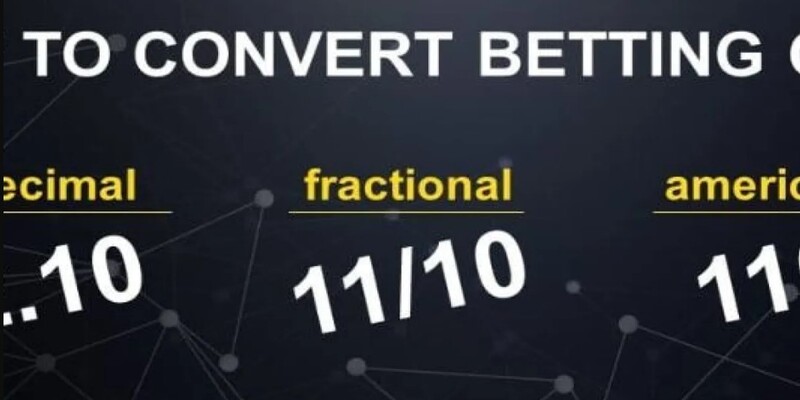
Fractional Odds are less common in America than Decimal Odds and American Odds. To protect their rights when betting, bettors who partake in Sports Betting in the US need to comprehend all Sports Betting Odds, including Fractional Odds.
What are Fractional Odds?
An approach for expressing Sports Betting Odds that is frequently used in the UK and Ireland is Fractional Odds. While Fractional Odds are not commonly utilized in the US, where Moneyline Odds, or American Odds, are more frequent, they are valuable when comparing betting markets outside of the country.
As fractions, Fractional Odds are typically expressed as 5/1 (read as “five to one”) or 7/2 (read as “seven to two”). They stand for the ratio of earnings to investment. The amount of money you will win if you bet the amount on the right (denominator) is represented by the number on the left (numerator).
Example:
– 5/1 odds mean for every $1 you bet, you will win $5 in profit, plus you get your $1 stake back, totaling $6.
– 7/2 odds mean for every $2 you bet, you will win $7 in profit, plus your $2 stake back, totaling $9.
Understanding Fractional Odds in the US

In practice, if you’re looking at a betting market and see fractional odds:
High fractional odds (e.g., 10/1) indicate a higher payout and usually represent a less likely outcome.
Low fractional odds (e.g., 1/4) indicate a lower payout and usually represent a more likely outcome.
Although this format are less common in the US, understanding them can help you navigate international betting sites and compare odds from different regions. Most US-based sportsbooks will convert these odds to American Odds to align with local preferences.
How to Convert Fractional Odds to American Odds
Few bettors truly know what Fractional Odds are because American Odds are the major focus of Social Sports Betting in the US. The odds can be converted to American Odds (Moneyline Odds) to make it more relevant to US bettors. Here’s how to easily convert them:
– For Positive American Odds (when the fraction is greater than 1/1):
Multiply the Fractional Odds by 100.
For example, 5/1 becomes (5/1) * 100 = +500.
– For Negative American Odds (when the fraction is less than 1/1):
Divide 100 by the Fractional Odds and then multiply by -1.
For example, 1/5 becomes (100 / (1/5)) * -1 = -500.
Example Conversions:
Fractional Odds 5/1:
– Calculation: (5/1) * 100 = +500.
=> American odds: +500.
Fractional Odds 1/5:
– Calculation: 100 / (1/5) = 500 * -1 = -500.
=> American odds: -500.
Fractional Odds Features

Fractional Odds have the following key features:
1. Format and Display
– Format of the Numerator and Denominator: Two integers, separated by a slash, are used to describe the odds (5/1, 7/2). The amount that you will win if you bet the denominator (right number) is represented by the numerator (left number).
– Readable Format: This format clearly displays the profit-to-stake ratio and is simple to read and understand.
2. A Profit-Oriented Approach
– Clearly Indicate: The odds indicate the profit component of a wager. For example, 4/1 odds indicate that you will benefit by 4 units for each unit wagered.
– Stake-Removed Estimate: The fractional representation does not include the stake, making the computation of profit alone simpler.
3. Historical and Regional Usage Tradition
Fractionals are strongly embedded in the betting cultures of the UK and Ireland, where they are primarily utilized in horse racing and other Sports Betting. They have been there for centuries.
4. Simplicity of Comparing
– Quick Comparison: By examining the ratios, bettors can quickly compare various bets. For instance, a fast comparison of the odds of 2/1 and 3/1 reveals which wager has a larger potential return.
– Value Identification: Bettors can more easily recognize value bets thanks to the profit’s straightforward display.

5. Calculating Implied Probabilities
– Easy Formula: Bettors can quickly convert the odds to implied probability to determine the likelihood of a particular result.
6. Transparency in Possible Returns
This format of Sports Betting Odds clearly show the profit per unit investment, and figuring out the total return (profit + stake) is simple and offers useful betting advice: 6/4 odds, for instance, indicate that a bettor will earn by 6 units for every 4 units placed, for a total return of 10 units (6 units profit + 4 units stake).
7. Flexibility for Varying Risks
– Scalable Representation: For a range of stake levels, this kind of odds perform admirably.
– Flexible Use: Fractional Odds are useful and adaptable for both little and large wagers because of their versatility.
8. Common in Specific Betting Contexts
– Horse Racing and Sports Betting in the US: Fractional Odds are particularly common in horse racing, greyhound racing, and other Social Sports Betting in the US contexts.
– Sportsbooks Standard: They are often the default format used by sportsbooks in these regions, making them a familiar and trusted system for local bettors.
These features contribute to the widespread use and acceptance of the odds in certain regions, providing clarity, ease of use, and a direct representation of potential profits from bets.
Conclusion
Fractional Odds do not factor in the stake when calculating returns, instead, they only consider the profit component of the bet. Bettors are better able to comprehend exactly what they stand to benefit from their stake thanks to this obvious division.
Fractional format are not very common in the US, but 2UP Casino and other Social Sports Betting Sites may be able to diversify Sports Betting Odds in the future.





